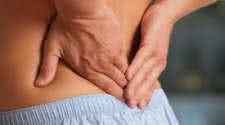Common Questions & Answers about Soreness and Joint Injuries

Always strive to minimize any injuries when involved with physical activities
Sometimes after I exercise a body-part really hard, it's still sore when the time comes to train it again. What should I do?
While muscle soreness is not a direct factor in muscular growth, it is an indication that you have trained the muscle hard enough to cause the adaptations needed for
hypertrophy. In this sense, some soreness is good. If you're constantly sore, however, you're getting too much of a good thing.
Delayed onset muscle soreness results from micro-tears in the muscle fibers. This damage at the cellular level is repaired as the muscle grows; but if you exercise
so much that your body is always sore, you never give your muscles the time they need to recuperate and grow.
Only you can determine the frequency and duration of training that is right for you. No one system works for everyone, because individual bodies vary. Individuals
also experience varying levels of stress in their work and their emotional relationships, and this often prolongs the recuperation process.
Of course, it is essential to get the raw materials your body needs for muscular growth from proper nutrition, but proper nutrition is not enough. Without adequate
rest and recuperation you will never grow.
Here's a good rule to follow for optimal recuperation: Never exercise a bodypart until it has been free from soreness for at least a day. If you find that applying this
rule gets in the way of your current workout regimen, try one of two things: stretch out your training schedule or reduce the number of sets you do per bodypart at each
workout. Some drug-free body-builders have changed from the traditional three-day division of bodyparts to a four-day split. Others have added a day or two of rest
between every exercise cycle. Both of these variations lengthen the period between training sessions for a particular bodypart and increase the time available for
recuperation.
Another option is to cut down on the number of sets for each bodypart. This way there is less stress on the muscle from each exercise session and less time needed for
recovery. Muscles grow from peak intensity- not from an excess volume of training. If you lift a few sets at your maximum weight and then find that the weights you use
keep dropping and dropping, you're better off stopping your bodypart workout right there. Any further sets will just increase the stress on your muscle and lengthen the
period of necessary recovery. So experiment with the number of sets you do. You may well find that your muscles grow more with fewer sets.
Do natural bodybuilders need to train differently in order to avoid joint injuries?
Joint injuries are usually brought on by overtraining or by poor lifting technique. One of the effects of steroids is a temporary increase in joint and muscle strength.
This allows drug users to lift more weight while they are "on the juice" and often gives them a false sense of confidence about their lifting ability. When they stop
taking the steroids and try to lift the same amount of weight they did before, joint injuries frequently result. Fortunately, drug-free bodybuilders never need to worry
about what will happen after they "go off," because they haven't been "on" to start with.
Natural athletes need to bear in mind, however, that their bodies recover more slowly from exercise than people who are on drugs. A major short-term benefit of steroids
is their ability to blunt the muscle and joint inflammation that results from exercise. They do this by retarding the secretions of the stress hormone Cortisol. This
allows the joints of steroid users to recover more quickly from exercise than those of natural athletes, so they can return to the gym sooner for another workout. If a
drug-free bodybuilder tries to keep up with a steroid user's routine and trains a bodypart before it is fully recovered, the potential for joint and muscle injury is
greatly increased. Also, remember to use proper form at all times. This will keep the risk of injury to a minimum.